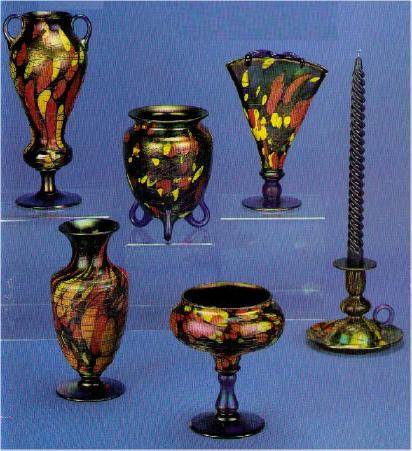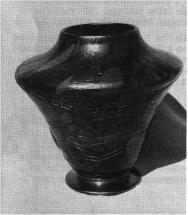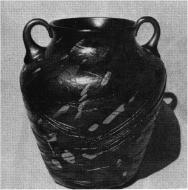National Depression Glass Association
Preserving America's Glass Manufacturing Heritage
Fenton's Mosaic
by Ferrill J. Rice
Glass Review - October 1985
Your cover this issue (the color photo at right)
features MOSAIC glass made by the Fenton Art
 Glass Company during the 1925-1926 period. Pieces of this glass may be
seen in William Heacock's Fenton Glass: the First 25 Years.
There you may see on page 28 the No. 3051 10½" vase, No. 3002
6¾" vase, a Pig whimsey, the No. 3024 vase, No. 3043 wall vase
and the No. 3055 oval shaped compote. Catalog pages showing this glass
may be seen on pages 80 and 107 of the same book.
Glass Company during the 1925-1926 period. Pieces of this glass may be
seen in William Heacock's Fenton Glass: the First 25 Years.
There you may see on page 28 the No. 3051 10½" vase, No. 3002
6¾" vase, a Pig whimsey, the No. 3024 vase, No. 3043 wall vase
and the No. 3055 oval shaped compote. Catalog pages showing this glass
may be seen on pages 80 and 107 of the same book.
The pieces on page 107 do not have any threading on them while those seen on page 80 all have threading. Shown in the color photo, left to right, top are the No. 3027 candlestick, No. 3028 Fan vase, No. 3039 vase and the No. 3051 vase. The bottom row displays a comport and the No. 3024 vase.
At the time this mosaic glass was being made a shop of glass workers from Europe, who were skillful in the methods of offhand art glass, were working in the Fenton factory. These men, who worked for Fenton for approximately one year, had worked in other places in the United States, including Durand and Imperial prior to coming to Fenton. While working at the Fenton company they made such colors as Karnak red, Oriental Ivory, Antique Green and Turquoise Blue. At this same time they made Mosaic.
Mosaic glass, as made at Fenton, is a glass that is gathered on the end of a hollow blow pipe, and that original gather is shaped in a wood block. Varied sized pieces of brightly colored glass, called frit, are spread on the metal marver, then the hot molten gather is rolled on the marver, picking up the "frit" incorporating the frit into the basic body of the glass.
 Some of these pieces will then have a fine thread of glass
decorating the outside as you can see in the photos here. Additionally,
handles, bases and other decoration might be applied. I don't believe I
have ever seen any of these handles or bases in any color other than a
cobalt blue. The threading appears to be of black glass.
Some of these pieces will then have a fine thread of glass
decorating the outside as you can see in the photos here. Additionally,
handles, bases and other decoration might be applied. I don't believe I
have ever seen any of these handles or bases in any color other than a
cobalt blue. The threading appears to be of black glass.
We consider Mosaic to always be of black amethyst glass with orange, red and yellow glass particles incorporated. However, the Fenton Museum has one piece of Mosaic that is Karnak Red with the red, orange and yellow frit.
 Mosaic is also like Karnak Red in that it is not a cased glass.
Because of this it is not heavy like some of the cased glass. But, it
is also not a very thin glass.
Mosaic is also like Karnak Red in that it is not a cased glass.
Because of this it is not heavy like some of the cased glass. But, it
is also not a very thin glass.
I believe one of the more frequent questions asked is about the confusion with similar glass imported from Europe, primarily Czechoslovakia, from about 1925 to 1935. Many of those pieces were marked with paper labels and today when those labels are missing is when the confusion comes. With a little study you can determine which is or is not Fenton. Again, study the front cover, Fenton books and pieces pictured here. Note the shapes and sizes. The Fenton pieces, are almost without exception, larger. The pieces are also heavier than the European. Also most of the European pieces have not been a black amethyst glass.
Once in a while one of the Mosaic whimseys appear. A person can well believe the humor of these glass workers as it comes through in their glass. There are two glass Mosaic pigs in the Fenton Museum. In the colored photo is a fan vase that has a snake curling across the top of it This curled snake actually becomes a glass frog, dividing the top of the vase into section to hold your flowers upright.